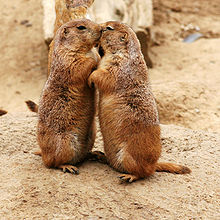
Prairie dogs are burrowing rodents native to the grasslands of North America. There are 5 species of prairie dog and the most commonly kept as a pet is the black tailed prairie dog. Prairie dogs require a lot of attention and have a long lifespan (8-12 years), so they are a significant commitment.

Additionally, there are some legal and ethical issues involved in the keeping of prairie dogs as pets:
In 2003, an outbreak of monkeypox lead to the banning of the capture of wild prairie dogs, and the trade in prairie dogs within states as well as between states in the United States. The outbreak was fairly mild but brought the exotic trade industry under scrutiny. Some experts claim that the prairie dog was unfairly scapegoated and that only import should have been banned. The EU also made import of these pets illegal. In 2008, the Federal ban on prairie dog trade was lifted, but some states still ban it.

All prairie dogs are caught from the wild as babies.They are removed from their underground burrows each spring, with a large vacuum device. These animals are meant to live in the wild and not in captivity.
Prairie dogs are considered to be a keynote species, and their removal from an ecosystem effects the entire ecosystem. Urban encroachment and the extermination of prairie dogs by farmers who see them as pests have already greatly reduced their numbers. The pet trade contributes to this problem as well.

Choosing a prairie dog
Because they are captured in the wild, it is only possible to adopt a prairie dog in the spring. Purchase from a dealer who is USDA licensed and uses humane ways to capture the animals. It is also crucial that the dealer allow the animals to adjust to captivity before selling them as pets. Ask the dealer to show you a health certificate as well as the USDA paperwork.
Prairie dogs can be kept in same-sex pairs or groups, or one male with females. If there is more than one male they will fight over the females. Males may emit a muskier odor than females. Make sure to spay or neuter your pet immediately after adoption.
Care

Prairie dogs are very social and need a lot of interaction so that they don't become depressed and ill. They enjoy the company of other prairie dogs, but if they bond with each other first, it will be difficult for them to bond with humans. It is best to keep them separately until they have bonded with the people in their lives and only then house them together.
When frightened, prairie dogs can become aggressive and inflict painful bites. For this reason, they may not be the best pets for children. It is important to learn to understand their body language and respond to their feelings.

Prairie dogs are fairly large and quite active so they need a big cage. Provide lots of toys, especially chewable ones. An exercise wheel is a good addition to the cage.
Prairie dogs eat a variety of grass hays, along with some rabbit pellets and small amounts of other greens, vegetables, and grains.

